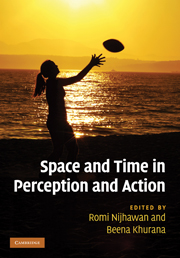Book contents
- Frontmatter
- Contents
- List of contributors
- Acknowledgments
- 1 Space and time: the fabric of thought and reality
- Part I Time–space during action: perisaccadic mislocalization and reaching
- Part II Temporal phenomena: perception
- Part III Temporal phenomena: binding and asynchrony
- 13 Dynamics of visual feature binding
- 14 How does the timing of neural signals map onto the timing of perception?
- 15 Mechanisms of simultaneity constancy
- 16 Relative timing and perceptual asynchrony
- 17 The time marker account of cross-channel temporal judgments
- 18 Simultaneity versus asynchrony of visual motion and luminance changes
- Part IV Spatial phenomena: forward shift effects
- Part V Space–time and awareness
- Index
- References
17 - The time marker account of cross-channel temporal judgments
from Part III - Temporal phenomena: binding and asynchrony
Published online by Cambridge University Press: 05 October 2010
- Frontmatter
- Contents
- List of contributors
- Acknowledgments
- 1 Space and time: the fabric of thought and reality
- Part I Time–space during action: perisaccadic mislocalization and reaching
- Part II Temporal phenomena: perception
- Part III Temporal phenomena: binding and asynchrony
- 13 Dynamics of visual feature binding
- 14 How does the timing of neural signals map onto the timing of perception?
- 15 Mechanisms of simultaneity constancy
- 16 Relative timing and perceptual asynchrony
- 17 The time marker account of cross-channel temporal judgments
- 18 Simultaneity versus asynchrony of visual motion and luminance changes
- Part IV Spatial phenomena: forward shift effects
- Part V Space–time and awareness
- Index
- References
Summary
Summary
The human sensory system, at least in its early stages, consists of multiple channels for different modalities (e.g., vision, audition) and for different attributes in each modality (color, motion). Temporal congruency is a critical factor in the binding of signals across channels, but little is known about what representations and algorithms are used for matching. We first analyze this mechanism from a general theoretical point of view and then address the specific mechanisms underlying the perception of color–motion synchrony and audiovisual simultaneity. We hypothesize that judgments about cross-channel temporal relations are based on the comparison of time markers by a mid-level perceptual process. The time markers are amodal tokens that reference salient, figural features extracted from early-level sensory signals. A temporal marker should reference the time a specific event occurs in the world rather than the time the processing of the event completes in the brain.
Introduction
The human sensory system has a complex architecture. It consists of multiple parallel channels for different sensory modalities (e.g., vision, audition). The channel for each sensory modality is subdivided into multiple parallel channels, each specialized for processing of different attributes (e.g., color, motion). Furthermore each channel consists of multiple serial processing stages. The transmission and processing of sensory information by neural mechanisms takes time, and the amount of time taken varies significantly across channels. For example, in monkey visual cortex, the latency of stimulus onset evoked response is about 40–100 msec in V1, 50–100 msec in MT, 70–160 msec in V4, and 90–180 msec in IT (Bullier 2001).
- Type
- Chapter
- Information
- Space and Time in Perception and Action , pp. 278 - 300Publisher: Cambridge University PressPrint publication year: 2010
References
- 4
- Cited by



